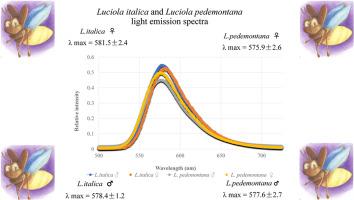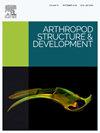Comparative analysis of light spectra emitted by two firefly species: Luciola italica and Luciola pedemontana
IF 1.3
3区 农林科学
Q2 ENTOMOLOGY
引用次数: 0
Abstract
Light plays an important role in fireflies (Coleptera, Lampyridae) and emission spectra and signalling patterns are usually species specific. In Italy there are two species of fireflies belonging to the genus Luciola: Luciola italica and L. pedemontana. No information was available on the light spectrum emitted by L. italica in vivo; moreover, the only data obtained on L. pedemontana dated back more than 50 years and were obtained using outdated measurement equipment. To fill this gap, we studied the spectra of adult males and females of both species. Samples were collected from the western central Po floodplain. Adults were sampled in the early part of the night when they were engaged in mating activity. The next day they were brought to the laboratory and their light emission was analysed using a spectrometer. The maximum emission wavelength (λ max) ranged from 571.8 nm to 584.8 nm. The values of λ max emitted by females of L. italica (581.5±2.4) and L. pedemontana (575.9±2.6) were significantly different. The plots obtained from the light emission measurements show a clear asymmetry, with a shorter tail on the left and a positive skew on the right. As light spectra depend on the structure of luciferases, such differences may indicate ongoing changes in the molecular composition of these enzymes resulting from the genomic divergence of the two species. The spectra of L. italica and L. pedemontana fall in the yellow region and are comparable to those of other Luciola species living in eastern Asia.

两种萤火虫的光谱比较分析:Luciola italica和Luciola pedemontana
光在萤火虫(鞘翅目,Lampyridae)中起着重要的作用,其发射光谱和信号模式通常具有物种特异性。在意大利,有两种属于Luciola属的萤火虫:Luciola italica和L. pedemontana。没有关于意大利乳杆菌在体内发射光谱的资料;此外,仅有的数据是50多年前的,而且使用的是过时的测量设备。为了填补这一空白,我们研究了这两个物种的成年雄性和雌性的光谱。样本采集自波河中西部漫滩。成年人在晚上早些时候进行交配活动时进行取样。第二天,他们被带到实验室,用光谱仪分析他们的光发射。最大发射波长(λ max)在571.8 ~ 584.8 nm之间。雌蜂发出的λ max值分别为581.5±2.4和575.9±2.6,差异有统计学意义。从光发射测量得到的图显示出明显的不对称,左边有一个较短的尾巴,右边有一个正斜。由于光谱取决于荧光素酶的结构,这种差异可能表明,由于两种物种的基因组差异,这些酶的分子组成正在发生变化。L. italica和L. pedemontana的光谱落在黄色区域,与生活在东亚的其他Luciola物种的光谱相当。
本文章由计算机程序翻译,如有差异,请以英文原文为准。
求助全文
约1分钟内获得全文
求助全文
来源期刊
CiteScore
3.50
自引率
10.00%
发文量
54
审稿时长
60 days
期刊介绍:
Arthropod Structure & Development is a Journal of Arthropod Structural Biology, Development, and Functional Morphology; it considers manuscripts that deal with micro- and neuroanatomy, development, biomechanics, organogenesis in particular under comparative and evolutionary aspects but not merely taxonomic papers. The aim of the journal is to publish papers in the areas of functional and comparative anatomy and development, with an emphasis on the role of cellular organization in organ function. The journal will also publish papers on organogenisis, embryonic and postembryonic development, and organ or tissue regeneration and repair. Manuscripts dealing with comparative and evolutionary aspects of microanatomy and development are encouraged.

 求助内容:
求助内容: 应助结果提醒方式:
应助结果提醒方式:


